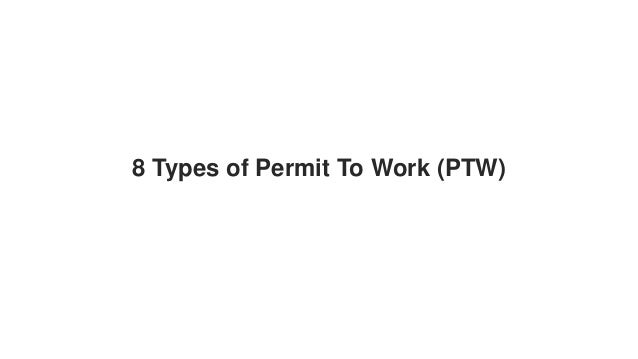
8 Types of Permit To Work (PTW.pdf
- 1. 8 Types of Permit To Work (PTW)
- 3. In this article, we will be discussing on the “Types of Permit to Work“. There are several types of permit to work, but within the scope of this article, we will talk about eight (8) types. Before we get into the types of work permit let us remind ourselves of what a Work Permit is. What is a Work Permit Work Permit or Permit To Work (PTW) is a safety program initiated for high risk activities. It is a core element of integrated safe system of work (ISSOW) systems, along with risk assessment and isolation planning. It enables as low as reasonably practicable (ALARP) reduction of unsafe activities in non-trivial work environments. Permit to work adherence is essential in process safety management.
- 4. Types of Permit to Work There are several types of work permits. Permit to work are develop to suit the task is it meant to cover; this is where we derive the types. 1. General Work Permit: General work permit is the job or the work which doesn’t involve work that can be included in Hot work, height work, confined space are considered as cold work. This generally includes the work in which no heat or spark will generate. The Cold work permits, typically blue-edged or the colored blue 2. Hot Work Permit: The Hot work is usually taken to apply to the operation that could include the application of the heat or the ignition sources to tanks, vessels, the pipelines etc., which may contain or have the contained flammable vapor, or in areas where the flammable atmospheres may be present. It is typically colored red or the red-edged.
- 5. 3. Height Work Permit: Authorization to work on elevated spaces (2m from the ground) be it ladders, scaffolds, Mobile Elevated Work Platforms (MEWP) and other spaces that are off the ground. 4. Confined space permit: A confined space entry also refer as vessel entry and OSHA defined the term permit-required confined space. Industries and some workplace have equipment and areas fall under Confined space which is not meant work person but has a provision for personnel entry to perform a certain task. They include any vessel, tank, container, pit, or any other similar space which has a very limited opening which is not suitable to work for a longer time and this enclosed system gives rise to the occurrence of an accident. 5. Excavation Work Permit: This permit covers the Authorization for personnel to mine or dig land in order to build infrastructure, extract resources or unearth hidden artifacts. The risk involved in excavation includes falling, being trapped, explosions, airborne contaminants, etc.
- 6. 6. Electrical Work Permit: Electrical work is any work where the worker or the worker’s tools will intentionally be in contact with electrically energized circuits. Testing and/or the use of testing equipment is not considered electrical work, unless the testing requires that the worker and/or the worker’s tools will intentionally be in contact with the electrically energized circuits. 7. Special Hazard Work Permit: Special hazard work permit and industry and workplace specific, designed based on the hazard present in that particular organization. Link Nuclear power station where the potential hazard is nuclear waster and radiation. In those industries, special hazard work permit are issues which are designed to safeguard person from those hazards 8. Chemical Work Permit: This covers the authorization to work with harmful chemical substances or in a chemically induced atmosphere that is either toxic or corrosive by nature. Chemical engineers that mostly work in chemical plants and labs. Continue Reading